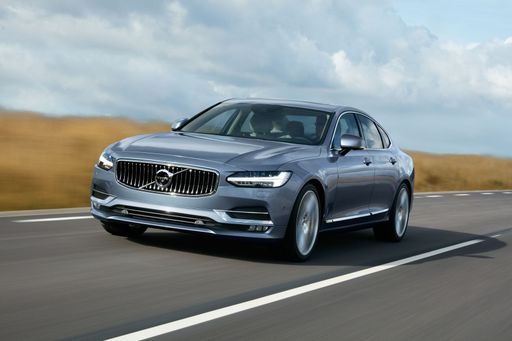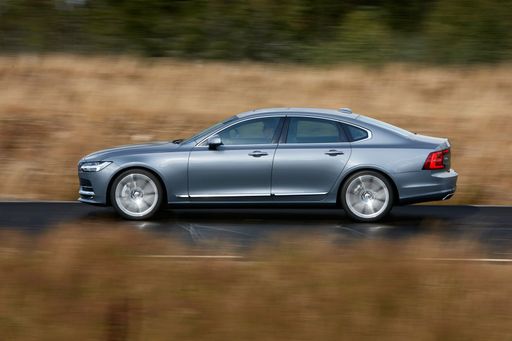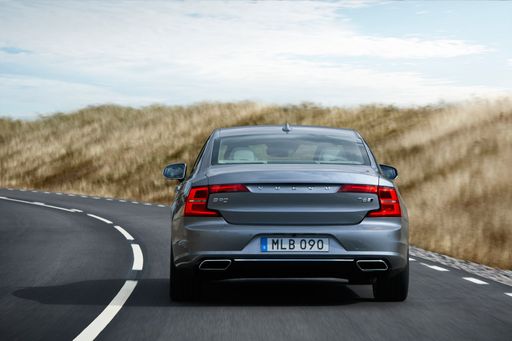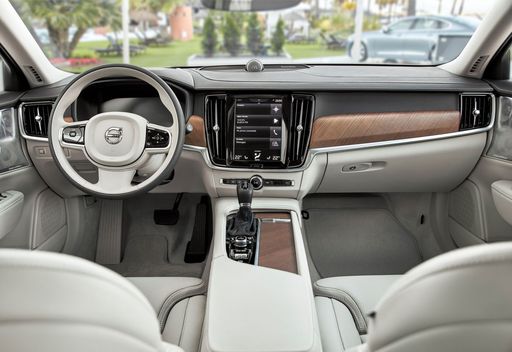Renault Trafic Bus VS Volvo S90 – Specs, Efficiency & Price Comparison
Which model is the better choice – the Renault Trafic Bus or the Volvo S90? We compare performance (150 HP vs 455 HP), boot capacity ( vs 453 L), efficiency (6.80 L vs 0.80 L), and of course, the price (38200 £ vs 62200 £).
Find out now which car fits your needs better!
The Renault Trafic Bus (Bus) is powered by a Diesel engine and comes with a Manuel transmission. In comparison, the Volvo S90 (Sedan) features a Diesel MHEV or Plugin Hybrid engine and a Automatic gearbox.
When it comes to boot capacity, the Renault Trafic Bus offers , while the Volvo S90 provides 453 L – depending on what matters most to you. If you’re looking for more power, you’ll need to decide whether the 150 HP of the Renault Trafic Bus or the 455 HP of the Volvo S90 suits your needs better.
There are also differences in efficiency: 6.80 L vs 0.80 L. In terms of price, the Renault Trafic Bus starts at 38200 £, while the Volvo S90 is available from 62200 £.
Compare all the key specs now and find out which model fits your lifestyle best!
Renault Trafic Bus
The Renault Trafic Bus is a versatile and spacious option for those needing to transport multiple passengers comfortably. With its modern design and practical features, it is well-suited for both business and leisure purposes. Its efficient engine and smooth handling make it a reliable choice for long journeys.
detailsVolvo S90
The Volvo S90 stands out as a symbol of Scandinavian luxury, combining elegant design with cutting-edge technology. Its spacious interior is adorned with high-quality materials, providing a comfortable and serene environment for both driver and passengers. Equipped with the latest safety features and intelligent driving aids, the S90 offers a smooth and confident driving experience.
details @ media.volvocars.com
@ media.volvocars.com
 @ media.volvocars.com
@ media.volvocars.com
 @ media.volvocars.com
@ media.volvocars.com
 @ media.volvocars.com
@ media.volvocars.com

|
|
|
|
|
Costs and Consumption |
|
|---|---|
|
Price
38200 - 51100 £
|
Price
62200 - 70500 £
|
|
Consumption L/100km
6.8 - 7.2 L
|
Consumption L/100km
0.8 - 5.7 L
|
|
Consumption kWh/100km
-
|
Consumption kWh/100km
-
|
|
Electric Range
-
|
Electric Range
89 km
|
|
Battery Capacity
-
|
Battery Capacity
14.70 kWh
|
|
co2
179 - 188 g/km
|
co2
17 - 149 g/km
|
|
Fuel tank capacity
80 L
|
Fuel tank capacity
60 L
|
Dimensions and Body |
|
|---|---|
|
Body Type
Bus
|
Body Type
Sedan
|
|
Seats
8 - 9
|
Seats
5
|
|
Doors
4
|
Doors
4
|
|
Curb weight
2031 - 2321 kg
|
Curb weight
1912 - 2119 kg
|
|
Trunk capacity
-
|
Trunk capacity
431 - 453 L
|
|
Length
5080 - 5480 mm
|
Length
4969 mm
|
|
Width
1956 mm
|
Width
1879 mm
|
|
Height
1973 - 1974 mm
|
Height
1440 mm
|
|
Payload
749 - 982 kg
|
Payload
451 - 518 kg
|
Engine and Performance |
|
|---|---|
|
Engine Type
Diesel
|
Engine Type
Diesel MHEV, Plugin Hybrid
|
|
Transmission
Manuel
|
Transmission
Automatic
|
|
Transmission Detail
Schaltgetriebe
|
Transmission Detail
Automatic Gearbox
|
|
Drive Type
Front-Wheel Drive
|
Drive Type
All-Wheel Drive
|
|
Power HP
110 - 150 HP
|
Power HP
235 - 455 HP
|
|
Acceleration 0-100km/h
13.6 - 16.5 s
|
Acceleration 0-100km/h
4.7 - 7 s
|
|
Max Speed
161 - 174 km/h
|
Max Speed
180 km/h
|
|
Torque
300 - 350 Nm
|
Torque
480 - 709 Nm
|
|
Number of Cylinders
4
|
Number of Cylinders
4
|
|
Power kW
81 - 110 kW
|
Power kW
173 - 335 kW
|
|
Engine capacity
1997 cm3
|
Engine capacity
1969 cm3
|
General |
|
|---|---|
|
Model Year
2023 - 2024
|
Model Year
2022 - 2024
|
|
CO2 Efficiency Class
G
|
CO2 Efficiency Class
E, B
|
|
Brand
Renault
|
Brand
Volvo
|
Renault Trafic Bus
A Glimpse into the Renault Trafic Bus: An Icon of Versatility and Innovation
Amongst the plethora of vans designed for both business and leisure, the Renault Trafic Bus stands out as an exemplar of functionality, innovation, and style. Let's delve into what makes the Renault Trafic Bus a popular choice in the UK and across Europe, particularly focusing on its technical specifications and state-of-the-art features.
Performance Dynamics: Power Under the Hood
The Renault Trafic Bus, a staple in Renault's fleet, is driven by a robust diesel engine configuration with power outputs ranging from 110 PS to a formidable 170 PS. The diesel engines combine efficiency and power, offering torque figures between 300 to 380 Nm, ensuring smooth power delivery and capable load hauling.
Drivers can choose between manual and automatic transmissions, both designed to complement the Trafic's front-wheel-drive system. This flexibility ensures that drivers experience enhanced driving comfort whether they are navigating urban roads or cruising on the motorway.
Efficiency Meets Economy
The Trafic Bus showcases impressive fuel economy with consumption figures ranging from 6.8 to 7.2 litres per 100 kilometres. This efficiency is crucial for businesses aiming to minimise operational costs and for families seeking budget-friendly travel options.
With a generous fuel tank capacity of 80 litres, the Renault Trafic Bus is built to cover long distances with fewer fuel stops, making it an ideal choice for long haul journeys.
Technological Innovations and Comfort
The Trafic Bus isn't just about robust performance. Renault has integrated a suite of technological innovations designed to enhance driver and passenger comfort. Its cabins are equipped with the latest infotainment systems and safety technologies, providing an optimal blend of comfort and convenience.
The various trims, such as Life, Start, Spaceclass, and their respective EDC variants, cater to different needs and preferences, ensuring that customers can find the perfect configuration for their requirements.
Design and Dimensions: Space for Every Purpose
Space and versatility are at the heart of the Trafic Bus design. With its dimensions ranging from a length of 5080 to 5480 mm, and a width of 1956 mm, this vehicle offers ample room for passengers and cargo alike. The height stands between 1973 and 1974 mm, ensuring that even taller individuals can travel comfortably.
With seating for up to eight people and a payload capacity between 730 to 1010 kg, the Trafic Bus can transform seamlessly between a people-mover and a goods carrier.
Environmental Considerations
Renault has engineered the Trafic Bus with environmental responsibility in mind. The CO2 emissions range from 178 to 190 g/km, which, while modest for its class, aligns with the efficiency and performance goals set for this versatile vehicle. The CO2 efficiency class is rated as 'G', offering transparency in its environmental impact profile.
Conclusion: A Leader in Its Class
The Renault Trafic Bus continues to lead its segment through a blend of power, efficiency, and technological advancements. Whether it's for commercial transport or family adventures, the Trafic offers a reliable and adaptable solution, setting a high standard for multi-purpose vehicles.
For those seeking a distinguished blend of utility and comfort, the Renault Trafic Bus emerges as an exceptional choice, promising performance and innovation on every journey.
Volvo S90
Innovating with Elegance: The Volvo S90 Overview
In recent years, Volvo has been at the forefront of automotive innovation, and the Volvo S90 is no exception. This luxurious executive saloon car is known for its cutting-edge technology, sustainability features, and Scandinavian design ethos. It is a manifestation of Volvo's commitment to quality, safety, and environmental responsibility.
Under the Bonnet: Power and Efficiency in Harmony
The Volvo S90 offers a range of advanced powertrains that cater to the needs of the contemporary driver. It includes a Diesel Mild-Hybrid option, which combines a 235 PS engine with all-wheel drive and an automatic gearbox, delivering a commendable fuel consumption of 5.7 L/100 km. This variant provides a balanced driving experience with a focus on efficiency and reduced emissions.
For those seeking an electrified experience, the T8 Plug-In Hybrid model produces an astonishing 455 PS, demonstrating that power and eco-consciousness can go hand-in-hand. This model boasts an impressive electric range of 89 km, with a fuel consumption as low as 0.8 L/100 km, making it ideal for both city commuting and long-distance touring.
An Innovative Approach to Hybrid Technology
Volvo's plug-in hybrid technology is at the cutting edge of automotive innovation, allowing drivers of the S90 to enjoy a smooth transition between electric and petrol power. The hybrid system incorporates a 14.7 kWh battery, which can be charged conveniently at home or on the go. With a combined torque of between 480 and 709 Nm, this sophisticated drivetrain ensures dynamic yet efficient driving.
Exquisite Design and Comfort
Embodying the finest aspects of Scandinavian aesthetics, the Volvo S90's design is both functional and elegant, measuring 4969 mm in length and 1879 mm in width. Its spacious interior features advanced ergonomics, offering seating for five and a boot capacity ranging from 431 to 453 litres, making it a practical choice for executive travel.
The S90's interior is fitted with premium materials, innovative technology, and safety features that are typical of Volvo's commitment to its passengers. From the minimalist dashboard to the intuitive infotainment system, every element is designed to enhance the driving experience.
Environmental Responsibility and Safety: A Volvo Legacy
Volvo has a long-standing reputation for prioritising safety and environmental sustainability. The S90 is no different, with CO2 emissions ranging from 17 to 149 g/km. The model achieves a CO2-efficiency class spanning E to B, underscoring its potential as an eco-friendly luxury car.
The brand's dedication to safety is evident in the comprehensive suite of safety features, from advanced driver assistance systems to a highly robust chassis. This ensures not only the wellbeing of those inside the car but also contributes to safer roads for everyone.
Conclusion: The Smart Choice for the Modern Executive
With its refined balance of power, efficiency, and luxury, the Volvo S90 stands out in the executive saloon segment. Whether you're drawn to its sleek design, its eco-friendly performance, or its state-of-the-art technology, the S90 proves to be a perfect union of practicality and prestige.
In an age where luxury means more than just lavishness, the Volvo S90 exemplifies a forward-thinking approach to motoring, offering a sophisticated driving experience that aligns with modern values and lifestyle demands.
The prices and data displayed are estimates based on German list prices and may vary by country. This information is not legally binding.
